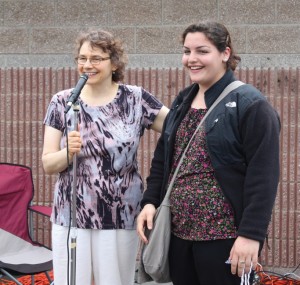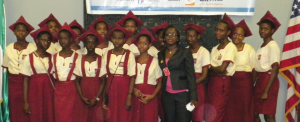Sixty high school girls sit in a classroom, eating pizza, as educator Cathi Rodgveller addresses the crowd. “How many of you girls know a woman in a science or technology career?”
Even in a technology-rich city like Seattle, only one or two hands typically go up in response to this question. A second cousin at Boeing, or a former neighbor at Microsoft. The vast majority of these girls have no female role models to encourage them to pursue science, technology, engineering, mathematics (STEM) careers. Their decisions are often driven by the all-too-skewed portrayals on television and in movies.
Rodgveller saw this problem more than 10 years ago, and her attempt to pique girls’ interest in nontraditional careers in the Seattle School District led to the creation of the now-international nonprofit IGNITE (Inspiring Girls Now in Technology Education). From its humble beginnings, IGNITE has impacted the lives of more than 20,000 girls, with thousands more across the globe each year.
In the Seattle School District, the majority of IGNITE’s funding comes from its ever-shrinking Perkins grant allocation. IGNITE’s appearance in the district made a significant impact; in schools where the program was rolled out, female enrollment in STEM classes jumped from 10 percent to 50 percent. But what is the secret to such success on a tight budget?
The IGNITE Curriculum
The beauty of the IGNITE program is its simplicity. At the heart of the program is a thriving partnership with professional women (and sometimes men) working in STEM careers, who volunteer their time in order to reach out to young women about the opportunities in front of them. Every IGNITE academic year begins with in-school presentations, during which a small panel of these profession¬als visit to tell their stories and engage in discussion with the girls in attendance.
For IGNITE members, this marks the beginning of a year filled with workshops, field trips, job shadows, mentorships, additional presentations, and the support and encouragement of peers and educators. But no matter what the year brings, it’s this personal connection with real fe¬male role models that inspires the girls to consider options they hadn’t seen before. Yet unlike some school presentations or career days, IGNITE exists year-round, creating a peer group for these girls that encourages them and increases the likelihood that the original outreach will take root.
Educators involved with the program have seen the inspiring results firsthand. Jacqueline Graupner, a counselor at Ingraham High School, recounts her first IGNITE field trip: “Feeling safe and encouraged, the girls expressed such an amazing level of interest in technology that the interaction between the adults and students was electric. The buzz continued on the bus ride back and repeats whenever IGNITE or related topics are brought up…I don’t know of any other program that is as dedicated to giving individualized guidance and inspiration to female high school students interested in technology. We are really very lucky here in Seattle.”
Many organizations offer workshops and hands-on training for girls in this age group. IGNITE increasingly collaborates with these organizations to give the girls easy access to exploratory opportunities once their curiosity is piqued, while providing the benefits of the peer groups IGNITE fosters among students. While the school district and grant money cover the cost of buses and substitute teachers, private donations from the community help IGNITE to go the extra mile, providing pizza at events, scholarships to promising students, and the like.
“The beauty of the IGNITE program is its simplicity. At the heart of the program is a thriving partnership with professional women (and sometimes men) working in STEM careers, who volunteer their time in order to reach out to young women about the opportunities in front of them.”
Expanding Focus
IGNITE’s success isn’t limited to the Seattle area. Over time, interest from others grew, and Rodgveller developed the IGNITE curriculum and a chapter model enabling other schools to implement the program and benefit from the best practices developed in the Seattle School District. IGNITE boasts chapters scattered across the United States, from California to New York.
Professional women and current IGNITE students celebrate the start of the first annual Brighter Future fundraiser walk in 2011
Recently, the success of the IGNITE model captured the attention of local and national lawmakers. In 2007, the program gained national visibility when IGNITE was awarded highest honors in the Association for Career and Technical Education’s “Programs and Practices that Work” awards program. The award provided IGNITE with recognition on Capitol Hill, which caught the attention of Sen. Maria Cantwell from Washington State. Since that moment, Sen. Cantwell has proven an enthusiastic supporter and valuable partner for IGNITE working with founder Rodgveller to develop legislation that would fund similar programs at the national level.
Presenting a Microsoft-sponsored scholarship award to IGNITE student Tugba Haklidir (right)
IGNITE students participating in a Teaching Kids Programming workshop
A new global focus for IGNITE emerged when the organization was approached by the State Department via Seattle’s World Affairs Council. These organizations have brought Rodgveller together with delegations from many foreign countries, enabling her to share the IGNITE model and her passion for this badly needed work. As word spreads about IGNITE’s model, partnerships with international school districts are emerging. The first international IGNITE chapter began in Ghana in 2007, joined by Nigeria in 2010. These incredibly exciting developments will soon be followed by new chapters in nations like India and Egypt. IGNITE is now pursuing translations for the curriculum to enable future global outreach.
The kickoff celebration for the first IGNITE chapter in Lagos, Nigeria
This new international interest has created an organizational challenge for IGNITE, but the challenges are far from insurmountable. No matter what hap¬pens, the Seattle School District provides an amazing opportunity for IGNITE to develop best practices that can then be documented and shared with our member chapters across the globe. In Seattle, Per¬kins funding enables the organization to keep active chapters in more than a dozen schools—though this still leaves some schools uncovered without additional funding.
A Lifelong Experience
IGNITE’s professional volunteers have great things to say about the experience of speaking to and working with the teens. But most inspiring are the tales of our students themselves. Christie Ong, a former student at Seattle’s Roosevelt High School, went on to become a Fulbright Scholar; she is so passionate about the IGNITE cause that she returned to serve as a consultant and volunteer. Former IGNITE student Chanvantha Sea, now a senior manager at Microsoft, shares her own story:
“I first heard of the IGNITE program when I was in high school…I still remember the fascinating ladies who came to speak to us about their career stories and the lessons they have learned throughout their journey. It was an incredible feeling to know that I, being an Asian American female, [could] be in a leadership role that would have huge impact and influence in a field of my interest. After graduating from college I joined Microsoft…I couldn’t resist but get more involved in [IGNITE’s] inspirational program. This program allows me to share my story, and the obstacles that I’ve overcome, with the young female leaders of today.”
The moral of IGNITE’s story is that it doesn’t take much to shatter stereotypes and excite young girls about the amazing opportunities that STEM careers can provide. Professional volunteers only spend a few hours a year speaking, but the impact of those words is long-lasting and far-reaching. IGNITE also works hand-in-hand with other community organizations bringing community college instructors in to speak to the girls to demystify higher education; partnering with local companies to provide field trips and scholarships; and collaborating with other educational nonprofits to provide a broad set of experiences for participants.
Though resources are tight, IGNITE also makes an attempt to expand beyond the high school years. IGNITE is offered at some middle schools within the Seattle School District; by getting the girls involved earlier, they will have more time to explore the science and technology offerings at school. Furthermore, IGNITE’s vision has always included a support network for these girls that reaches to college and beyond. Seattle Central Community College and Spokane Community College also sponsor IGNITE chapters, providing an unbroken chain of support throughout some students’ academic lives.
Long-term, IGNITE hopes to create a permanent network of IGNITE alumni and volunteers across the globe. Technology today enables these lasting communications even once our students lose their geographic proximity to their home schools. And the longer IGNITE keeps in touch with graduates, the more likely they are to become role models and mentors themselves once they’ve completed their own educational journeys.
Changing Stereotypes
There is certainly a stigma attached to engineering, notes Google Vice President Marissa Mayer. In an article, “A Woman’s Place,” (see The New Yorker Web site, for July 11, 2011), Mayer said, “They [women] don’t want to become the stereotype of all-night coders, hackers with pasty skin.” That same article goes on to point out that Hollywood has done its part in upholding stereotypes. The article’s author, Ken Auletta, writes: “Several female computer-science majors at Stanford pointed to the depiction of women in films like ‘The Social Network,’ where the boys code and the girls dance around in their underwear.” IGNITE is working to counteract these stereotypes.
A Model Program
If your district also suffers from lagging female participation in STEM classes, the IGNITE model would be an ideal, cost-effective way to start. IGNITE’s simple but powerful spark has changed lives. The recipe for success is both accessible and reproducible in any school district interested in investing in the future of our nation’s STEM workforce. Educators interested in inspiring young women in their schools in partnership with IGNITE can contact cathi@ ignite-us.org for more information, or visit www.ignite-us.org. We can change the world together, one school at a time.
Women Still Underrepresented in STEM Careers
According to data from the National Science Foundation (NSF), in 2009 only 25 percent of computing/math positions and 11 percent of engineering positions were held by women. In contrast, women make up 47 percent of the employed workforce. (You can access this and more NSF data at www.nsf.gov/statistics/ wmpd/digest/theme4.cfm.) Even more alarming is the fact that these numbers have dropped since the mid 80s in some categories, and may continue to drop; according to the National Center for Women and Information Technology, only 18 percent of new computing-related degrees were granted to women.
While it’s long been accepted that there is a challenge in recruiting young women to pursue STEM careers, there is growing awareness of a pronounced retention problem for women in STEM. Female students of all ages are more likely to abandon STEM studies for lack of support or fulfillment from the material being taught. Programs like IGNITE hope to address both sides of the equation.
- Cheryl Platz is a senior user experience designer for Microsoft. She can be contacted at cheryl@cherylplatz.com.
- Cathi Rodgveller, M.S. Ed., is the non-traditional career coordinator for the Seattle School District, and founder/director of the IGNITE program.
Interested in exploring this topic further? Discuss it with your colleagues on the ACTE forums atwww. acteonline.org/forum.aspx




